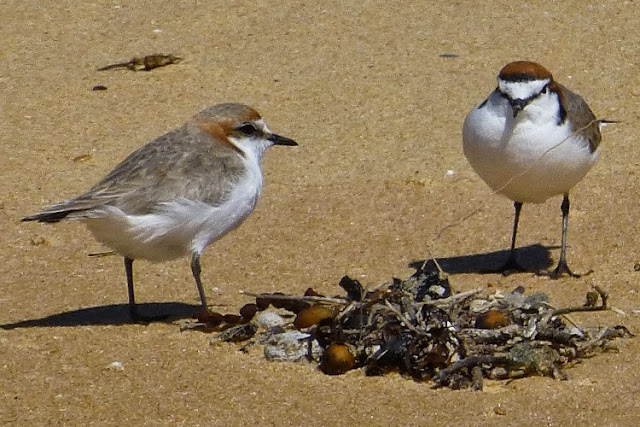Our centre of operations was Bermagui, about 400 km south of Sydney, and the purpose was to gather material for an upcoming book.
We worked known geological sites, and prowled the areas to see what else was around. Please note: I am not a geologist, and my conclusions, while reasonably informed, are open to question.
Our first beach was Barragoot, south of Bermagui, and that was mainly to look at the dunes there for yet another book. Still, no sooner had we set foot on the southern end, where a lagoon feeds into the sea, than we had a major find:
These four pictures show (I think) a male red-capped plover. My confidence was increased when I managed to get the next two shots:
I believe that the bird on the left in the first shot, and on the right in the second shot is a female. This plover is classed as endangered: it nests on the open beach. We learned about it on a previous field trip when we mistook another bird for this one.

 Well, that messed up our plans for the beach a bit, because we needed to stay off the dry sand at the back of the beach, but we headed several hundred metres down the beach before veering up, once we had left the parent birds well behind. Even so, we were very cautious.
Well, that messed up our plans for the beach a bit, because we needed to stay off the dry sand at the back of the beach, but we headed several hundred metres down the beach before veering up, once we had left the parent birds well behind. Even so, we were very cautious.We worried, though, because of some strange tracks that we found, the ones you can see here to either side. They appeared to be made by a heavy animal, perhaps hopping on one leg. For the most part, they were too indistinct for us to recognise.


We followed them along until we came to these, which looked rather more like a four-legged carnivore. People are usually barred from walking dogs in areas where the plovers nest, but there were no accompanying human tracks.
 I just hope the birds are OK. There were quite a few birds on the beach that were not OK, and it seems that quite a few shearwaters (alias mutton birds) have been dying off the coast.
I just hope the birds are OK. There were quite a few birds on the beach that were not OK, and it seems that quite a few shearwaters (alias mutton birds) have been dying off the coast.These wash ashore and provide food for a variety of life forms: small land shrimps, about 4 mm long, small earwigs, and also crows.
Life goes on.
So did we, having sated our interest in matters biological, we headed on down to bother the rocks at the southern end.
The rocks of the south coast are curious. At Myrtle Beach, near Durras Lake, the base of the Sydney Basin rises above sea level, and I will come to that in a later post.
All of a sudden, we go from early Permian, maybe 300 million years old, to Ordovician, perhaps 450 to 500 million years old. That means the rocks we were looking at had a great deal of history: they had been formed, buried, heated, run through by hot liquids, maybe even by molten rock, they have been bent and bashed, so there is always some mystery there.
The veins you see here have to be quartz, because I succeeded in scratching a glass bottle on them, but I confess my ignorance as to what that means.
More Research Needed!
Next time: folds and faults at Aragunnu, bird-covered rocks, a dyke, an intrusion, and some columnar-jointed rhyolite at Mimosa Rocks.
For more stuff like this:
I add tags to all of my blogs, and my tags are fairly WYSIWYG. Look further down, and click on one of the links.
Or
* Sapphire Coast Geo Trails, part 1, Bermagui and North.
* Sapphire Coast Geo Trails, part 2, Bermagui to Tathra.
* Sapphire Coast Geo Trails, part 3, South of Tathra.
Part 2
Part 3
Part 4
Part 5




No comments:
Post a Comment